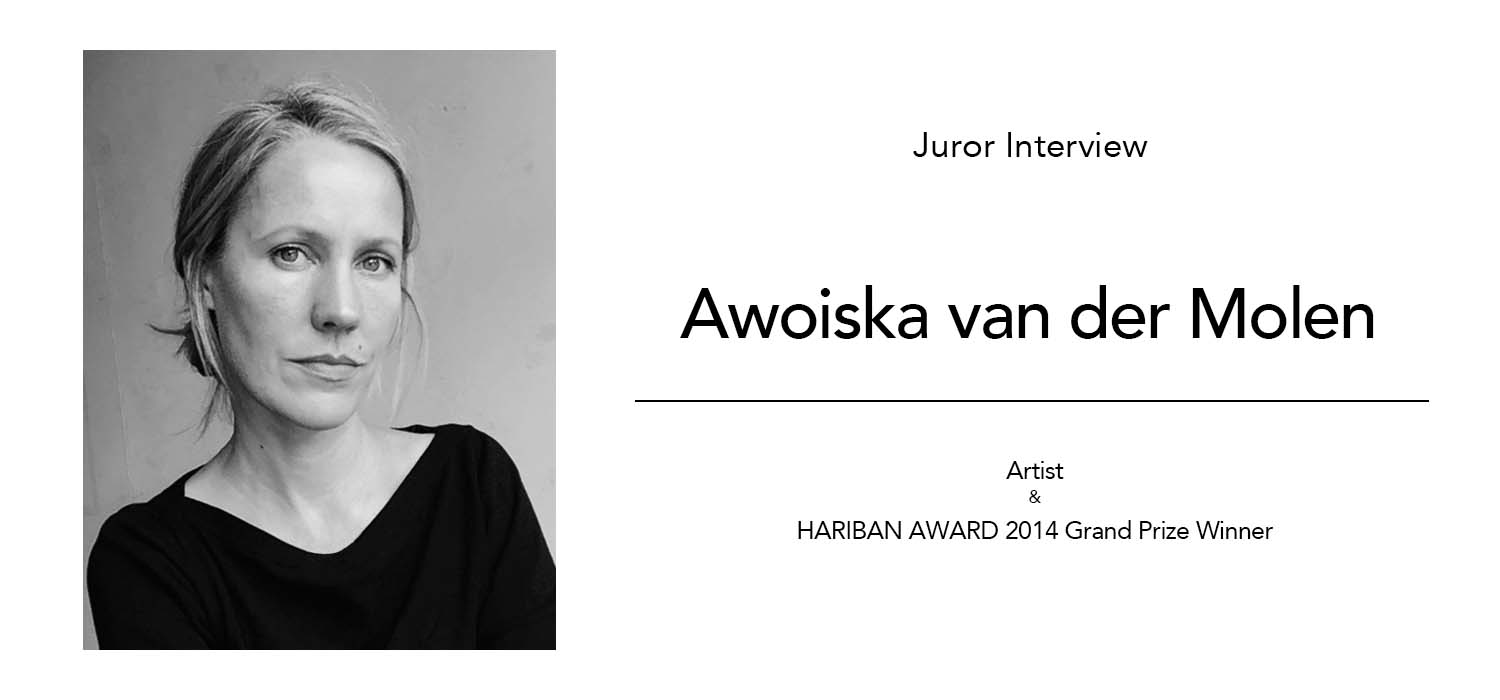Interview|Awoiska van der Molen
As part of the HARIBAN AWARD 2023 programme, we interviewed one of this year’s Juror Awoiska van der Molen, Artist and HARIBAN AWARD 2014 Grand Prize Winner.
What was the first time you learned about photography? What was the event that inspired you to pursue photography?
Awoiska van der Molen (A/M): That’s an interesting question to start with, who knows if this first time was a traumatic event… It was the mid-1970s, and I must have been four years old when I found a stack of photographs in my mother’s drawer: She was dressed in a beautiful purple long gown, holding flowers, warmly smiling, looking up towards a tall man with a beard in a brown suit. I didn’t know who this man was. I thought this was a wonderful series of images and I placed them next to each other on the mantelpiece. When my mother came into the room, she was shocked and horrified to see these photographs and immediately took them away. I can’t remember if, at that right moment, she tore up the wedding pictures she had with who appeared to be my father. She told me later that she had destroyed the pictures: it was a very traumatic relationship. This was my first encounter with photography and, definitely, with the emotion it can evoke.
It was around ten years later when I was a teenager that I would often find black and white photographs sticking wet on the bathroom walls to dry when going to the bathroom at night. My mother was attending evening art school, where besides painting she also printed negatives, mostly of my siblings and me, in the darkroom. The variety of different sizes of paper, test strips, and the simple act of making little gems of images fascinated me. It took still two other prematurely terminated studies before I surrendered to the arts, to photography. These other studies could have resulted in a structured 9–5 life with a secure income. That seemed like heaven to me since I came from a chaotic household. When I was twenty-five and clueless about what to do with the rest of my life, luckily a friend took me to a darkroom and photography course, and I was sold.
What basic ideas have you been working with? And, also, please tell us about your own works that you are particularly attached to and your memories of the production process.
A/M: I spend long periods of time in the natural world. My images arise out of the longing to arrive at the essence of the remote places in which I create my photos. I return to our native territory: the unspoilt nature with her natural rhythm. Being here for longer periods of time I experience a higher plane of existence to which humanity once had access but lost substantive contact with.
After exploring these remote places for many years there are three to four images that have become very dear to me. These photographs each made me have an epiphany about the understanding of my work or myself. During the creation process, it is such a big joy for me to receive these insights from the images, instead of the thinking, rational brain.
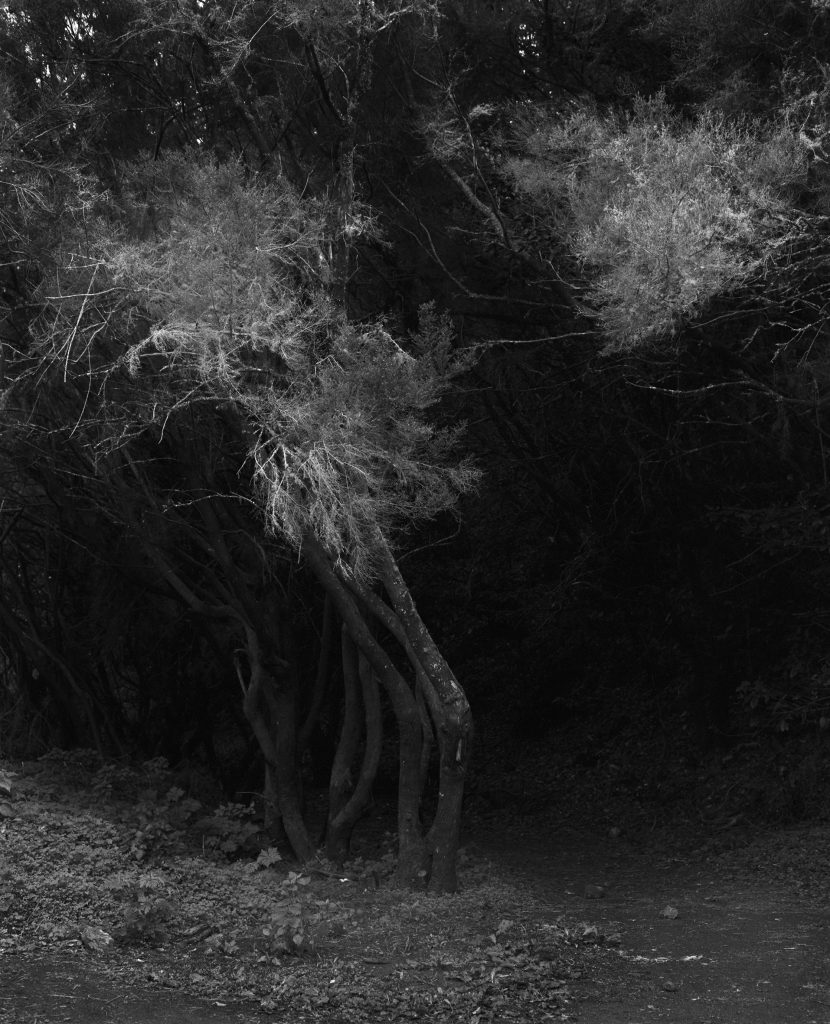
Please tell us about the project you are working on now, if you don’t mind.
A/M: During recent work trips in nature, the early stages of a new direction in my photography gradually emerged ― I started to notice situations in the urban area that continue to touch me and they are now growing into a new body of work. In this man-made environment, I experience the same kind of ‘psychological space’ I do in my landscape works. I look very much forward to presenting this new series in a solo show at Huis Marseille photography museum in Amsterdam in 2024.
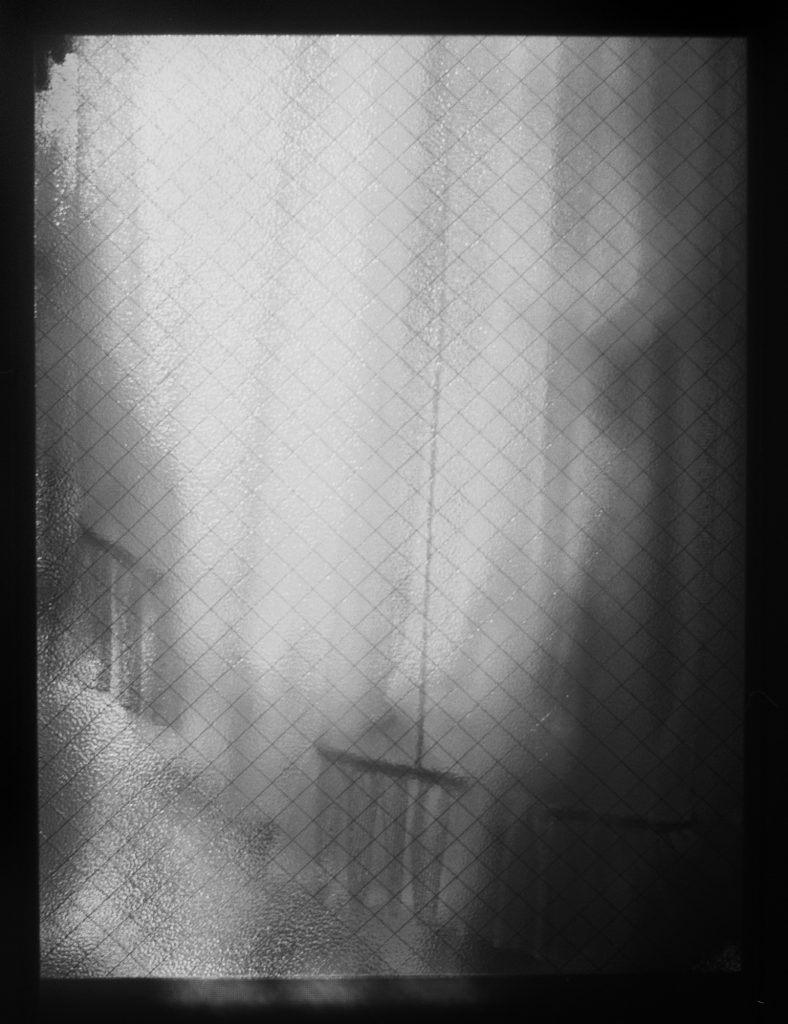
You won the Grand Prize in the first edition of the HARIBAN AWARD in 2014, what prompted you to apply? Were you familiar with Collotype before that?
A/M: I was not familiar with the Collotype print at that time. When I was reading about the Hariban Award I was very much drawn to the possible opportunity to have my images printed in collaboration with artisan printers. I was curious to get to know this rare production process that has so much more depth and possibilities than the silver gelatin prints I print by myself. I applied without a doubt, as I wanted to see my works arise through the artisans’ eyes and hands born and influenced by their immense cultural heritage.
What was your impression when you did a two-week residency in Kyoto and your work was finished in collotype?
A/M: It was impossible to imagine beforehand how this two-week residency and collaboration would be, and how I’d appreciate the collotype process. It was thrilling to be part of the inspiring exchange of ideas between me and the master printers. Thanks to them I discovered new layers and possibilities latent in my already existing images that I hadn’t seen before. It showed me new ways how to emphasize depth in my photographs through subtle layers of darkness and light. This collaboration and the knowledge I gained had a lasting influence on my art practice afterwards. I can’t print collotypes at my own studio, but I treat the negatives that I made in our current roaring world with all my attention in the darkroom where the echoing of the Benrido printer voices would accompany me from time to time.
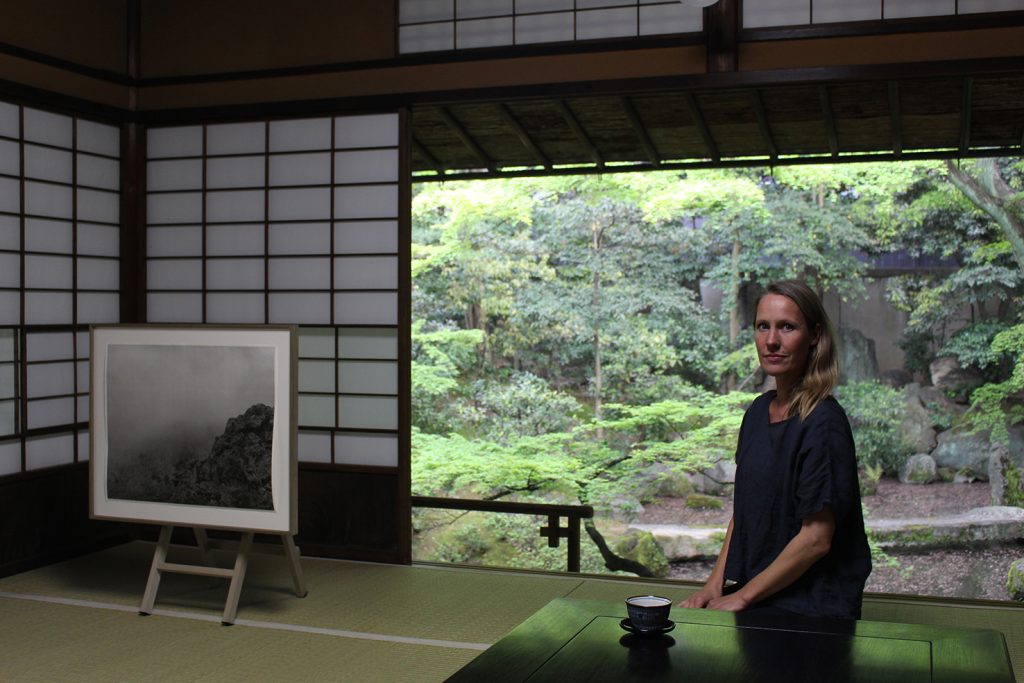
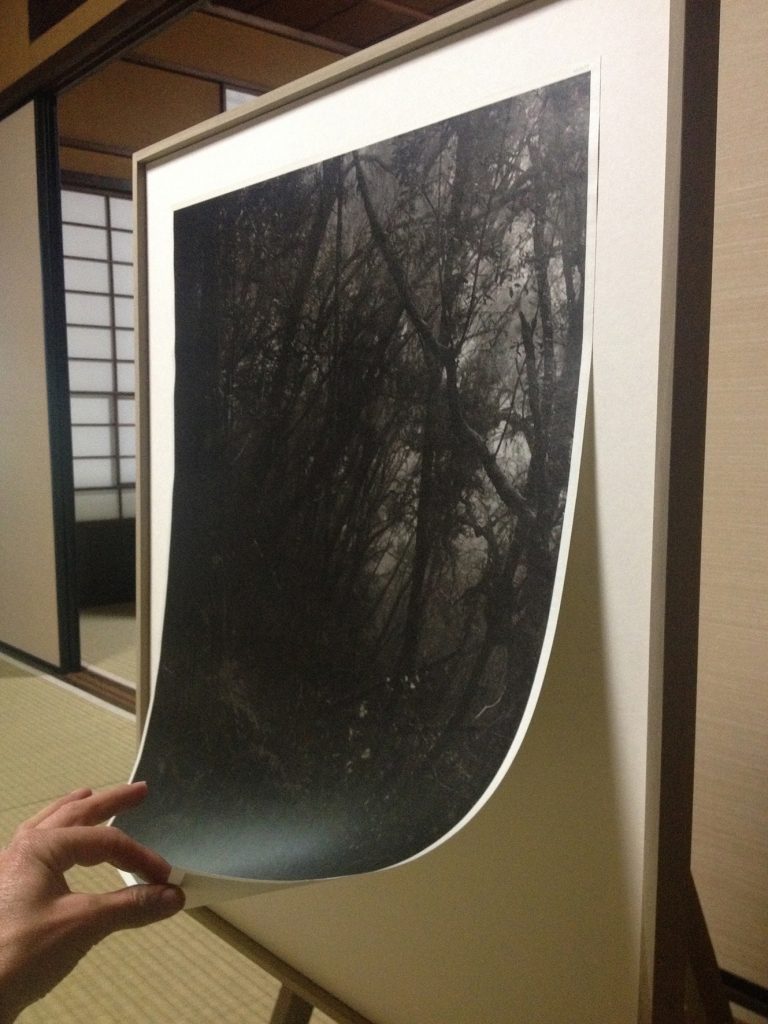
Since then, you have produced other works at Collotype in addition to your award-winning works, for what reason did you choose Collotype for that?
A/M: I remember 2014 jury member and curator Naoko Ohta said that: ‘In Japan, the collotype process is used to print mostly holy objects such as calligraphies and sutra manuscripts. Collotypes have the power to produce the depth and detail of these works faithfully, awakening the hidden messages and spirits within them.’ When I had made photographs of Japanese nature in the years after the two-week residency, I could sense the mystical spirit of the spaces in Japanese nature ― this is why I was very keen to have these images merged with the collotype technique.
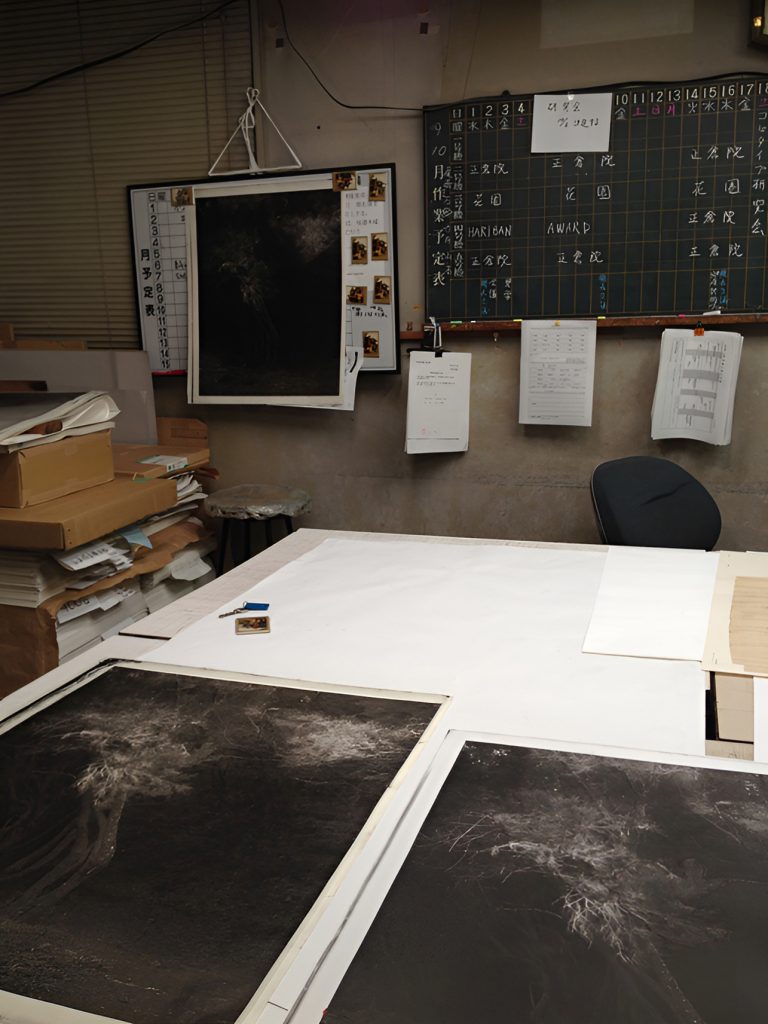
Do you have a message for those who are considering applying for the HARIBAN AWARD 2023?
A/M: If you are an artist that finds the subject and the content of your photographic work as important as thinking about which paper, which layer, and which tones your photographs need to strengthen this particular work, then you must have a strong body of work in your hands that you could send in. So please do!
Awoiska van der Molen
Artist
Awoiska van der Molen is a Dutch artist living in Amsterdam. In 2003, she graduated with an MFA in Photography at the Breda St. Joost Academy in the Netherlands. She is known for her monumental black-and-white images of the natural world. Her work has been exhibited at numerous institutions worldwide. In 2019 Van der Molen was shortlisted for the Prix Pictet prize and in 2017 for the Deutsche Börse Photography Foundation Prize. Van der Molen was the Grand Prize Winner of the very first Hariban Award in 2014.
HARIBAN AWARD 2023 の審査員インタビューでは、アーティストであり、HARIBAN AWARD 2014の最優秀賞受賞者のアヴォイスカ・ヴァン・デル・モレンさんにインタビューをおこないました。
はじめて写真を知った時のこと、また、写真を志すきっかけとなった出来事について教えてください。
面白い質問から始まりましたね。この初めての出来事がどれほど衝撃的であったかは誰にも分かりません… それは 1970 年代半ばのことで、私は4才くらいだったと思います。母の引き出しの中に写真の山を見つけました。母は美しい紫色のロングガウンを身に着け、手には花を持ち、あたたかい微笑みを浮かべて、茶色のスーツに身を包みひげを生やした背の高い男性を見上げていました。この男性が誰なのか知りませんでしたが、これは素晴らしい一連のイメージだと思ってマントルピースの上に並べて置きました。部屋に入ってきた母はショックを受け、これらの写真を目にしてぞっとした様子で、すぐに持ち去ってしまいました。この時に母が私の父親と思われる人物と撮った結婚式の写真を破り捨てたかどうかは思い出せませんが、後に彼女は私に、写真、つまり非常にトラウマ的な関係の写真は破棄したと言いました。これは私と写真、そして間違いなく写真が呼び起こす感情との最初の出会いでした。
それから約10年後、私が10代の頃、夜中にバスルームに行くと、白黒写真が濡れたまま壁に貼られて乾燥されているのをよく見かけました。母は夜間の美術学校に通っていて、絵を描く以外にも主に私たち兄弟を写したネガを暗室でプリントしていました。さまざまなサイズの印画紙に、テストピース、そして小さな宝石のようなイメージをプリントする単純な行為に私は魅了されました。私が芸術、写真に身を委ねるまでには、2 度程他の分野のことを学ぶ機会がありました。これらの他の分野では、組織化された9時から5時までの生活と安定した収入が得られる可能性がありました。混沌とした家庭環境に育った私にとって、それは天国のように思えました。私が 25 歳の時、これからどのように生きようかまだ糸口がつかめずにいたときに、幸運にも友人が私を暗室と写真のコースに連れて行ってくれ、私はその世界に進むことを納得したのです。
これまでにどんなコンセプトで活動をされてきましたか?また、特に思い入れのある作品やその制作過程の思い出等も教えてください。
私は制作のために、長い時間を自然の中で過ごします。私の作品は、写真を撮るために訪れる人里離れた場所の本質に辿り着きたいと渇望することから沸き起こります。私は私たちの生まれ故郷、つまり自然のリズムが残る手付かずの自然に向かいます。そこに長い時間滞在していると、人がかつてはアクセスできたのに実質的な接触を失ってしまった、より高次元の存在を知らされます。長年にわたってこれらの人里離れた場所を探究した結果、私にとって非常に大切な写真が 3 ~ 4 枚あります。それぞれの写真から私は自分の作品や自分自身について理解するための悟りを受けました。創作の過程において、思考や理性的な脳の働きではなく、イメージからこれらの洞察を受け取ることができるのは、私にとってとても大きな喜びです。

今取り組まれているプロジェクトについて教えてください。
最近、自然の中で仕事をしている中で、私の写真の新しい方向性の初期段階が徐々に現れてきました。都市部の環境が私に影響を与え続けてきたこと気づき、この気づきは既に新しい一連の作品にまで成長しています。都市部の人工的な環境は、私は風景と同じような「心理的空間」を感じます。 2024年にアムステルダムのハイス・マルセイユ写真美術館で開催される個展で、この新シリーズを発表することをとても楽しみにしています。

HARIBAN AWARDの第一回目である2014年に最優秀賞を受賞されましたが、その応募のきっかけは何でしたか?またそれ以前にコロタイプはご存知でしたか?
当時私はコロタイプについてよく知りませんでした。HARIBAN AWARDについて読んだとき、印刷職人とコラボレーションし、私の写真作品をプリントできるということに非常に惹かれました。自分でプリントするゼラチンシルバープリントよりもはるかに奥深く、可能性を秘めたこのコロタイプの珍しい制作プロセスを知りたいと思いました。(便利堂が多く手がけてきた)文化遺産に携わる仕事の経験から影響を受けてきた職人たちの目と手を通して、自分の作品が生まれるのを見たいと思い迷わず応募しました。
実際に京都で2週間のレジデンスをし、自分の作品がコロタイプで仕上がった時の印象を教えてください。
この 2 週間の滞在とコラボレーションがどのようなものになるか、そしてコロタイプのプロセスをどのように感じるか、事前に想像することは不可能でした。私は印刷職人と互いに刺激し合い、アイデアを交換することができたことをとても嬉しく思いました。彼らのおかげで、私はこれまで見たことのなかった、見慣れたイメージの奥深くに眠っていた新しいレイヤーとその可能性を発見しました。それは、暗闇と光の微妙な層を通して写真の奥行きを強調する新しい手がかりを私に教えてくれました。このコラボレーションの体験と私が得た知識は、その後の私の作家活動に明らかな影響を与えました。自分のアトリエでコロタイプをプリントすることはできませんが、便利堂の職人の声が聞こえてくるような暗室で、騒々しい世界で撮ってきたネガに写る写真と心をこめて対峙しています。


その後、受賞作以外にもコロタイプで作品を制作されていますが、コロタイプを選んだ理由はなんですか?
2014年の審査員でキュレーターの太田菜穂子さんが次のように述べたことを覚えています。「日本では、書道や経典など主に神聖な物の印刷にコロタイプが使用されています。コロタイプには、これらの作品の深みと細部を忠実に再現し、作品の中に隠されたメッセージと精神を目覚めさせる力があります。」2週間の滞在後、何年かかけて日本の自然の写真を撮ったとき、日本の自然に宿る神秘的な精神世界観を感じることができました。― これが、私がこれらの画像をコロタイプと融合させたいと強く思う理由です。


